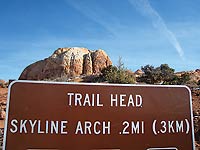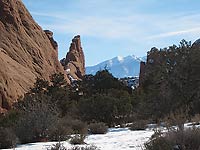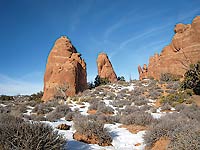Here’s how arches are made: Start with a big sandstone fin. Then wait while the water seeps into the cracks and collects at the weaker points. As time marches on, a chemical reaction between the water and the rock will break down the natural silica cement that holds everything together. When that happens, rock particles begin to slough off. Meanwhile the relentless cycle of freezing and thawing creates a pressure so powerful it acts like a sledgehammer until larger chunks eventually fall out. After awhile an opening appears. Gradually it enlarges and over the years the wind cleans up the mess by blowing away loose particles.
 Now anticipation runs high - a million years is a long wait for the final product, but the last step is the trickiest: it involves a test of balance and stability. If by some miracle the structure doesn’t topple over, and the opening measures at least three feet, you’ve got an arch! Even today, new arches are born, while old ones suddenly collapse.
Now anticipation runs high - a million years is a long wait for the final product, but the last step is the trickiest: it involves a test of balance and stability. If by some miracle the structure doesn’t topple over, and the opening measures at least three feet, you’ve got an arch! Even today, new arches are born, while old ones suddenly collapse.
Some of the earliest settlers in Moab made regular excursions into “The Arches,” and word started to spread about this arch-filled wonderland. But it remained low-key until 1922 when the gold prospector Alexander Ringerhoffer, after exploring the area, started a campaign to establish it as a national monument or park. On April 12, 1929, this possibility turned into reality when President Herbert Hoover signed legislation to establish the area as a national monument. Then in 1971, Congress voted to upgrade Arches to a national park.
 Arches National Park boasts one of the world’s greatest densities of natural arches with over 2,000 catalogued within its boundaries. Hosting more than a million people every year, the biggest draws are Delicate Arch, Devil’s Garden, and The Windows.
Arches National Park boasts one of the world’s greatest densities of natural arches with over 2,000 catalogued within its boundaries. Hosting more than a million people every year, the biggest draws are Delicate Arch, Devil’s Garden, and The Windows.
A short hike to the lesser known Skyline Arch, however, with its majestic setting and immense dimensions should also be included on every visitor’s must-see list. In 1940 a large chunk of sandstone fell from its girth doubling its size to its current dimensions of 71 feet across and 33.5 feet in height. Bit by bit this impressive landmark is falling apart. Some day its stately configuration, too, will tumble to the ground.
Located in the northern part of the park Skyline Arch brazenly stands out above the eastern horizon. Positioned near the top of a fin its distinctive image remains visible for miles in Salt Valley, and like a desert lighthouse guides travelers back to the main road.
 To get to Skyline Arch, from Moab travel five miles north on Highway 191 to the park’s entrance. From the visitor center drive approximately 17 miles to the trailhead on the right side of the road.
To get to Skyline Arch, from Moab travel five miles north on Highway 191 to the park’s entrance. From the visitor center drive approximately 17 miles to the trailhead on the right side of the road.
Despite the nippy, mid-winter weather, I am determined to wander in (almost half a mile) for an engaging look at this spectacular arch. A mere 50-foot ascent is all it takes to reach the bottom of the fin where this impressive large outdoor window is housed. But the temperature holds steady at 23 degrees and when I step out of my car - BRRR, it’s bitter out here, especially with a piercing breeze making it feel much colder on this crystal, clear day.
Climbing up a few handmade rocky steps, Skyline Arch immediately comes into view and stays with me during the whole walk through the classic desert vegetation of Mormon tea, saltbush, snakeweed, yucca, blackbrush and prickly pear cactus. Bundled up like a penguin, I cautiously tread over an icy, snow-coated trail. Along the way I pass by weird rock formations with the wildly imaginative shapes of fat mushrooms popping up out of the ground - figures with big lips and funny noses - sway-backed camels - tubular towers - spiraling pinnacles - and rocks with enormous potbellies.
After many pauses I eventually reach the base of Skyline’s sandstone wall. Now craning my neck, the immensity of this massive arch encasing a chalky blue sky now sinks in. This arch is huge!
No one else shows up and blessedly I am alone. Craving the continuation of this by-myself-experience I stubbornly stick around so I can soak in the gifts of a wintry world: powdered snow like icing on a lopsided cake is sprinkled over uneven layers of red velvet sandstone – a dazzling display of crystallized snow that glitters like thousands of sparkling diamonds – the Christmas tree scene of pinyons and junipers decorated with tinsels of ivory fluff.
Oh how I treasure the rarified silence of this sheltered spot, this vacuum of serenity – no traffic – no voices – no roaring machinery. Only the breeze stirs from above, only a raven calls from afar. The solitude settles over me until the numbing cold forces my retreat back to the real world - the modern convenience of the sheltered warmth of my car!
 The sheer drop of the sandstone wall makes it impossible to reach the bottom of Skyline Arch from the front side where I’ve just been. But I know by doing some scrambling and rock-hopping the possibility exists of following a primitive route on its backside, which begins at the amphitheater. So I continue a short distance up the road and drive in at the campground. After parking at the entrance to the amphitheater, I’m ready to give it a go as this intriguing arch comes in to view. The steeply slanted slickrock, however, covered with a huge bank of snow immediately halts me in my tracks. It is most definitely too treacherous to proceed any farther!
The sheer drop of the sandstone wall makes it impossible to reach the bottom of Skyline Arch from the front side where I’ve just been. But I know by doing some scrambling and rock-hopping the possibility exists of following a primitive route on its backside, which begins at the amphitheater. So I continue a short distance up the road and drive in at the campground. After parking at the entrance to the amphitheater, I’m ready to give it a go as this intriguing arch comes in to view. The steeply slanted slickrock, however, covered with a huge bank of snow immediately halts me in my tracks. It is most definitely too treacherous to proceed any farther!
With the day warming up and the breeze slowing down to a whimper, I’m perfectly happy to just wander around as a cottontail hippity-hops in front of me and a canyon wren vocally flits away. Seeing this arch from the opposite direction is so satisfying, especially with the snow-laden La Sal Mountains presenting their own heavenly alpine profile on the southeastern horizon. I definitely don’t mind taking advantage of this exquisite winter scene knowing I can return when the snow is gone.
Soon the ethereal beauty of this unrushed, uncrowded time of year will be over. I’ve been savoring it while it lasts. But I am also looking forward to the longer, warmer days of spring and the dramatic changes that season brings!
 Now anticipation runs high - a million years is a long wait for the final product, but the last step is the trickiest: it involves a test of balance and stability. If by some miracle the structure doesn’t topple over, and the opening measures at least three feet, you’ve got an arch! Even today, new arches are born, while old ones suddenly collapse.
Now anticipation runs high - a million years is a long wait for the final product, but the last step is the trickiest: it involves a test of balance and stability. If by some miracle the structure doesn’t topple over, and the opening measures at least three feet, you’ve got an arch! Even today, new arches are born, while old ones suddenly collapse. Arches National Park boasts one of the world’s greatest densities of natural arches with over 2,000 catalogued within its boundaries. Hosting more than a million people every year, the biggest draws are Delicate Arch, Devil’s Garden, and The Windows.
Arches National Park boasts one of the world’s greatest densities of natural arches with over 2,000 catalogued within its boundaries. Hosting more than a million people every year, the biggest draws are Delicate Arch, Devil’s Garden, and The Windows.  To get to Skyline Arch, from Moab travel five miles north on Highway 191 to the park’s entrance. From the visitor center drive approximately 17 miles to the trailhead on the right side of the road.
To get to Skyline Arch, from Moab travel five miles north on Highway 191 to the park’s entrance. From the visitor center drive approximately 17 miles to the trailhead on the right side of the road.
 The sheer drop of the sandstone wall makes it impossible to reach the bottom of Skyline Arch from the front side where I’ve just been. But I know by doing some scrambling and rock-hopping the possibility exists of following a primitive route on its backside, which begins at the amphitheater. So I continue a short distance up the road and drive in at the campground. After parking at the entrance to the amphitheater, I’m ready to give it a go as this intriguing arch comes in to view. The steeply slanted slickrock, however, covered with a huge bank of snow immediately halts me in my tracks. It is most definitely too treacherous to proceed any farther!
The sheer drop of the sandstone wall makes it impossible to reach the bottom of Skyline Arch from the front side where I’ve just been. But I know by doing some scrambling and rock-hopping the possibility exists of following a primitive route on its backside, which begins at the amphitheater. So I continue a short distance up the road and drive in at the campground. After parking at the entrance to the amphitheater, I’m ready to give it a go as this intriguing arch comes in to view. The steeply slanted slickrock, however, covered with a huge bank of snow immediately halts me in my tracks. It is most definitely too treacherous to proceed any farther!